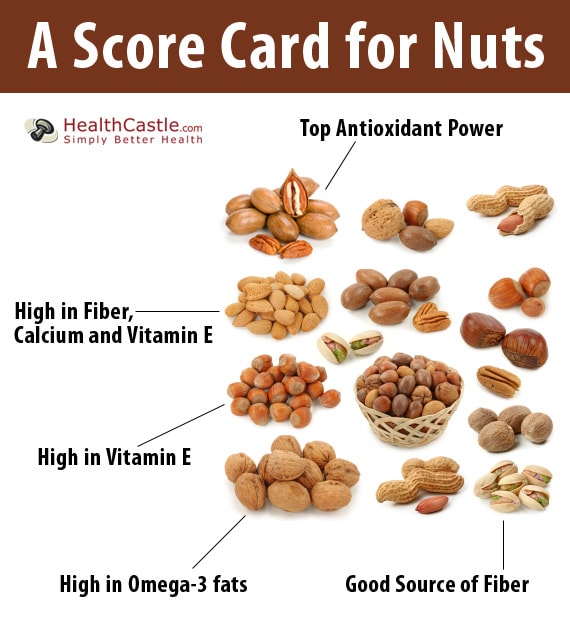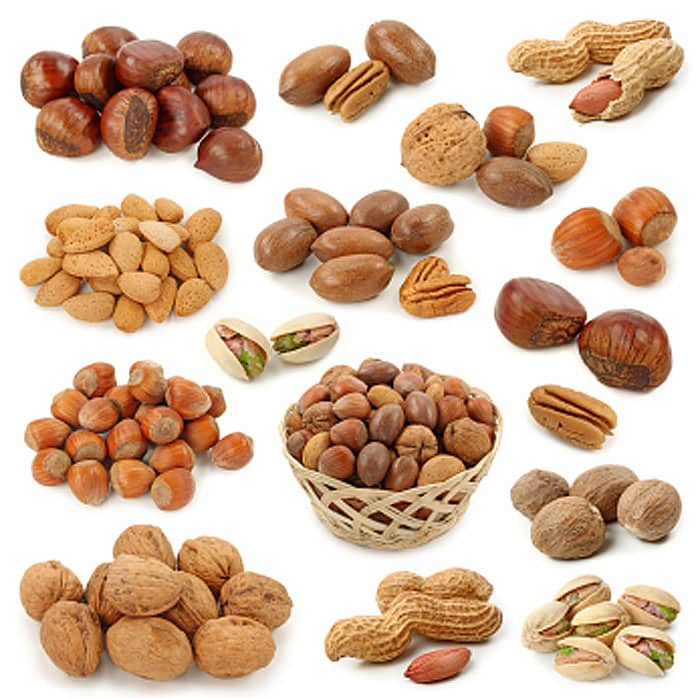
Written By: Owennie Lee, RD
Title: Registered Dietitian
Alumni: University of British Columbia
Last Updated on:

Nuts are undoubtedly nutritional powerhouses. Not only are they one of the best sources of plant-based protein, they are also rich in fiber, phytonutrients, and antioxidants such as Vitamin E and selenium, as well as omega-3 fatty acids. No wonder they have been shown by many researchers to lower the risk of heart diseases. However, nuts are not all the same when it comes to their nutrient profiles. We’ve analyzed the nutritional profiles of various nuts, and compared their nutrition values.

Table of Contents
If you are watching your weight, you might want to include fewer macadamia nuts and pecans in your nut mixes. Opt for the lowest calorie nut – the pistachio (13 g fat and 162 calories) – instead.
The type of omega-3 fatty acid present in most nuts is alpha-linolenic acid (ALA), which has been shown to help lower LDL cholesterol, and lower blood triglycerides and blood pressure. The highest omega-3 nut is walnuts; most other nuts don’t have such a high level. The distant second, pecans, offer 0.28 g per ounce.
Nuts are a great option if you are looking for a high-fiber snack. One ounce of almonds (roughly 23 almonds) contains 3.3 g fiber, making it the perfect high-fiber food to boost your fiber intake.
Although you probably will not be meeting your daily calcium requirement by munching on nuts alone, every single bit counts. Almonds and Brazil nuts are great choices for plant-based calcium.
Nuts are also a renowned source of Vitamin E, which acts as an antioxidant, scavenging for free radicals that can damage cells and contribute to cardiovascular disease and cancer. An ounce of almonds will provide half of your daily requirement for Vitamin E (15 mg/day or 22.4 IU).
ORAC is a scale that quantifies the antioxidant capabilities of various foods. The ORAC of 19 pecan halves is higher than half a cup of pomegranate juice (5853 umol TE). That’s not a bad way to add more antioxidant power to your day.

All nuts are nutritious, but they are not made equal. Almonds scored high in fiber, calcium, and Vitamin E, while walnuts’ omega-3 fat content is unparalleled. While nuts make nutritious snacks, they are also high in fat and calories. Choose unsalted, unflavored, and dry-roasted (versus oil-roasted) varieties, and enjoy up to 1.5 oz. of nuts daily.
Alumni: University of British Columbia – Owennie is a registered dietitian with a soft spot for chocolate and coffee. She is a believer in balance and moderation, and is committed to keeping healthy eating enjoyable and fun. Owennie received her dietetics training in Vancouver, and is a member of Dietitians of Canada and the College of Dietitians of British Columbia. She has experience in a wide variety of settings, such as clinical nutrition, long-term care and outpatient counseling. Owennie has also worked for a community nutrition hotline and participated regularly as a guest radio host, where she enjoyed sharing her passion and knowledge about food and nutrition with people.
antioxidant, calcium, calories, fiber, high fiber nuts, nutrition comparison, nuts, nuts nutrition, omega 3 nuts, omega-3, vitamin e
Nuts and seeds are often confused.. The author failed to mention flax seeds which have considerable fiber and are very high in ALA.
We should acknowledge that Omega 3’s from nuts do not contain EPA and DHA (which come from fish or kelp) since these are recognized to also be very beneficial.